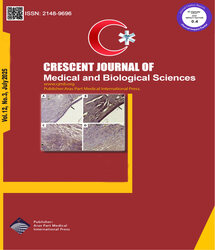| Original Article | |
| Antifibrotic Efficacy of Topical Tranexamic Acid: Macroscopic and Molecular Evidence in a Rabbit Model of Epidural Fibrosis | |
| Arian Rahmani1, Soroush Mohitmafi1, Fariborz Moayer2, Mohammad Molazem3 | |
| 1Department of Clinical Science, Karaj Branch, Islamic Azad University, Karaj, Iran 2Department of Pathobiology, Karaj Branch, Islamic Azad University, Karaj, Iran 3Department of Surgery and Radiology, Faculty of Veterinary, University of Tehran, Tehran, Iran |
|
|
CJMB 2025; 12: 150-156 DOI: 10.34172/cjmb.2025.3789 Viewed : 42 times Downloaded : 27 times. Keywords : Epidural fibrosis, Laminectomy, Rabbit, TGF-β, Tranexamic acid |
|
| Full Text(PDF) | Related Articles | |
| Abstract | |
Objectives: Epidural fibrosis (EF), characterized by excessive scar tissue formation in the epidural space, is a significant complication following spinal surgery, often causing persistent postoperative pain. Given the association between postoperative hematoma accumulation at the laminectomy site and EF, this study aimed to investigate the preventive effect of tranexamic acid (TXA), an antifibrinolytic agent known for its hemostatic properties, on EF formation. Materials and Methods: Twenty-six adult male New Zealand White rabbits were randomly assigned to either a control group (saline) or a treatment group (topical TXA). Each rabbit underwent a two-level laminectomy at the L3-L4 vertebrae. The treatment group received 5 ml of 100 mg/mL TXA solution topically at the laminectomy site, while the control group received 5 ml of saline. At postoperative week 6, macroscopic adhesion assessment and histopathological analysis were performed to quantify inflammatory cells, vessel density, and collagen concentration in scar tissue at the laminectomy site. Additionally, TGF-β and VEGF expression were evaluated in IHC-stained sections. Results: Macroscopic evaluation showed significantly reduced adhesion in the TXA-treated group compared to the control. Histopathological analysis revealed lower collagen concentration and TGF-β expression in the TXA group, while inflammatory cell count, vessel density, and VEGF expression showed no significant differences between groups. Conclusions: These findings provide evidence of the efficacy of topical TXA in preventing EF in a rabbit model of spinal surgery. The topical use of TXA appears to be a promising therapeutic strategy for preventing EF and warrants further investigation to evaluate its effectiveness and potential clinical applications. |
Cite By, Google Scholar
Google Scholar
PubMed
Online Submission System
 CJMB ENDNOTE ® Style
CJMB ENDNOTE ® Style
 Tutorials
Tutorials
 Publication Charge
Women's Reproductive Health Research Center
About Journal
Publication Charge
Women's Reproductive Health Research Center
About Journal
Aras Part Medical International Press Editor-in-Chief
Arash Khaki
Deputy Editor
Zafer Akan




























